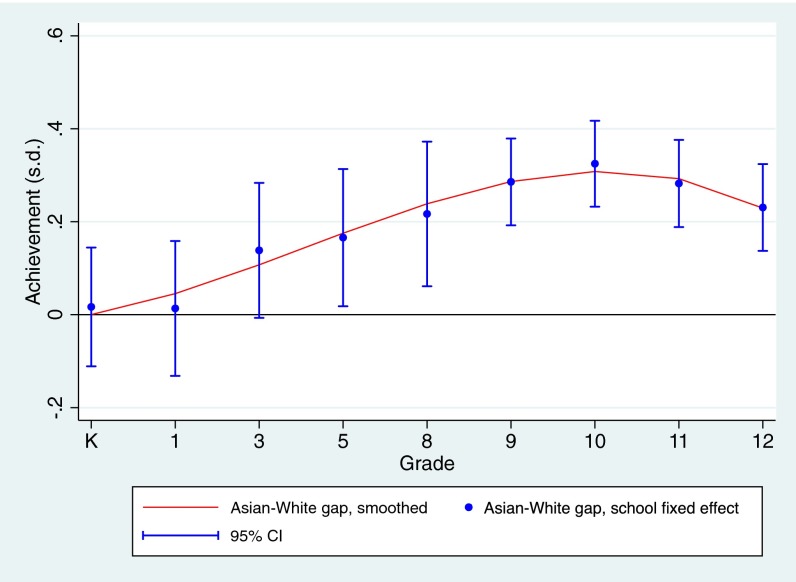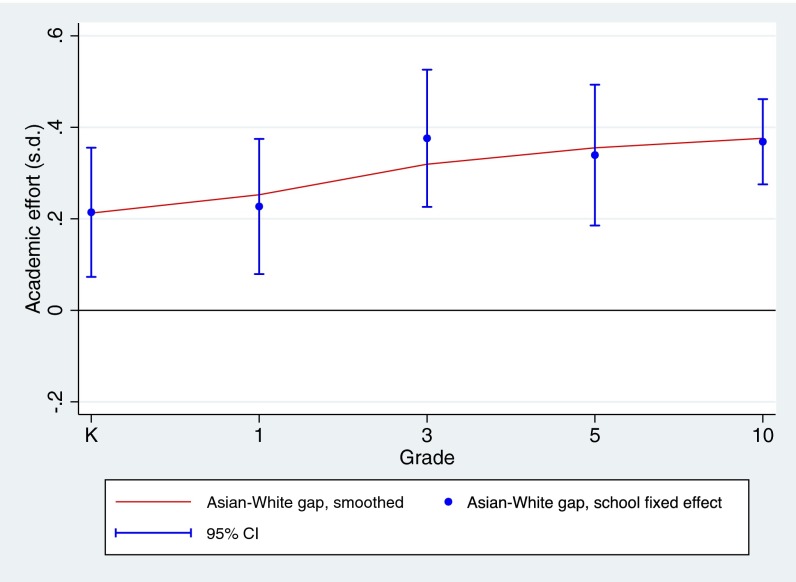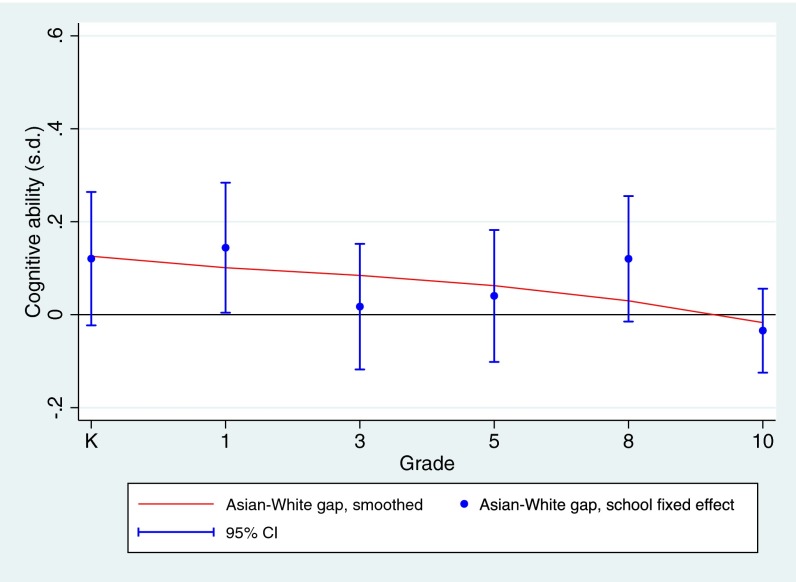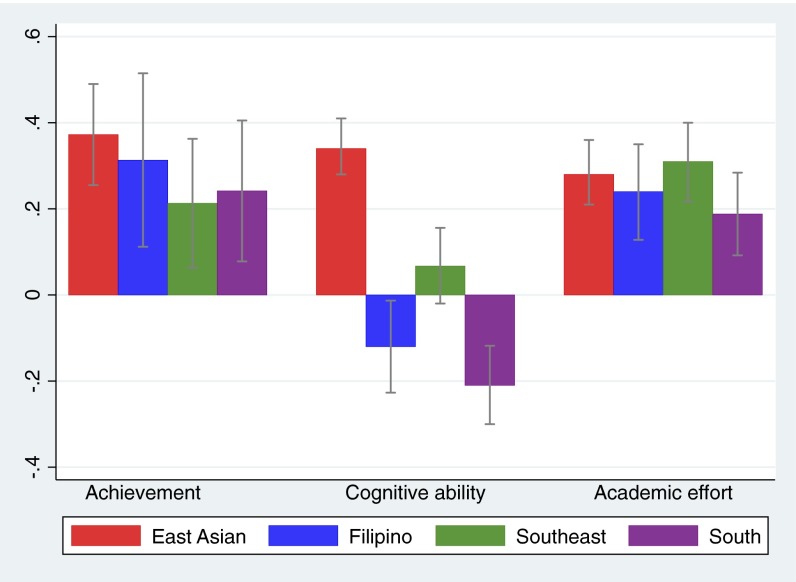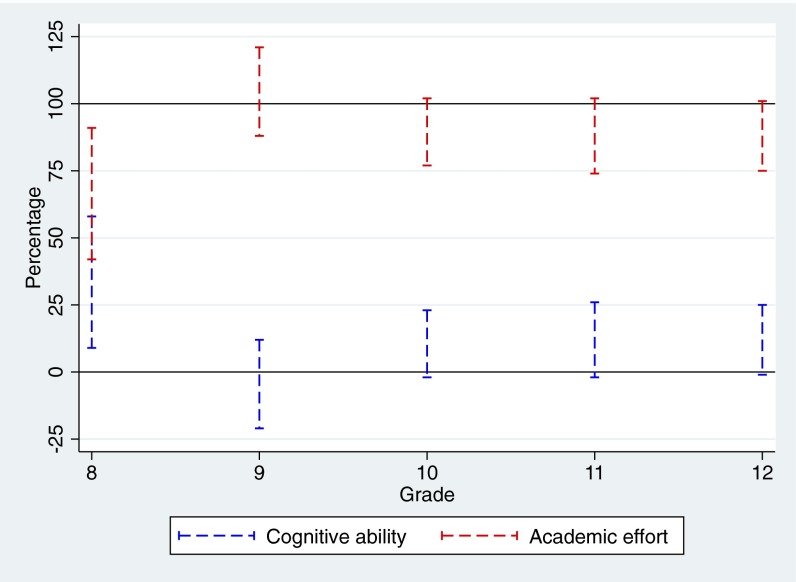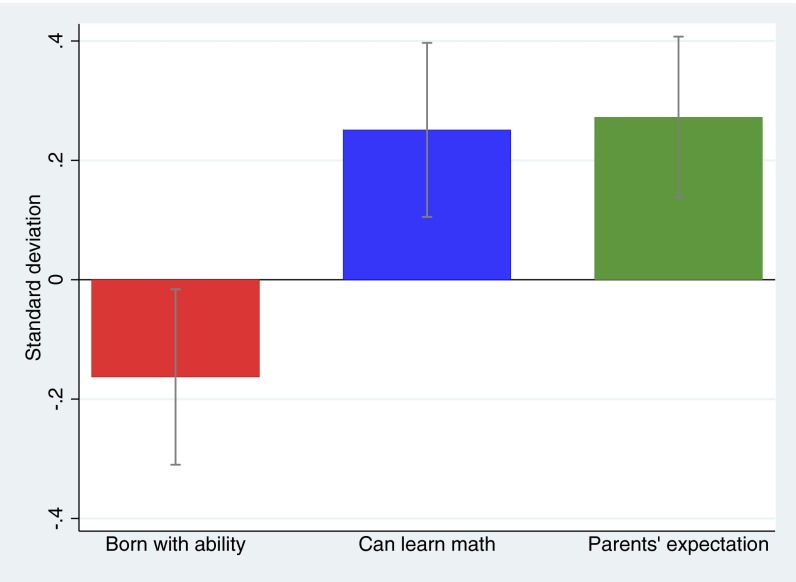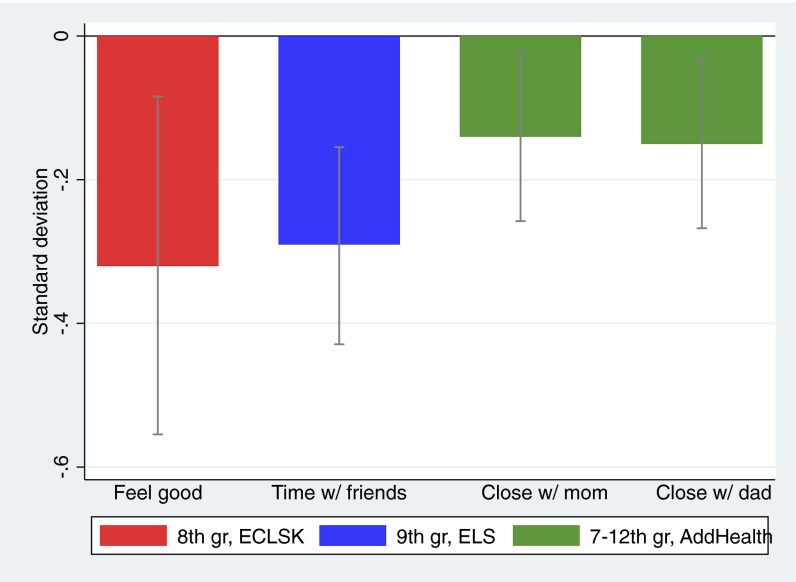Significance
We find that the Asian-American educational advantage over whites is attributable mainly to Asian students exerting greater academic effort and not to advantages in tested cognitive abilities or socio-demographics. We test explanations for the Asian–white gap in academic effort and find that the gap can be further attributed to (i) cultural differences in beliefs regarding the connection between effort and achievement and (ii) immigration status. Finally, we highlight the potential psychological and social costs associated with Asian-American achievement success.
Keywords: noncognitive skills, model minority, Asian advantage
Abstract
The superior academic achievement of Asian Americans is a well-documented phenomenon that lacks a widely accepted explanation. Asian Americans’ advantage in this respect has been attributed to three groups of factors: (i) socio-demographic characteristics, (ii) cognitive ability, and (iii) academic effort as measured by characteristics such as attentiveness and work ethic. We combine data from two nationally representative cohort longitudinal surveys to compare Asian-American and white students in their educational trajectories from kindergarten through high school. We find that the Asian-American educational advantage is attributable mainly to Asian students exerting greater academic effort and not to advantages in tested cognitive abilities or socio-demographics. We test explanations for the Asian–white gap in academic effort and find that the gap can be further attributed to (i) cultural differences in beliefs regarding the connection between effort and achievement and (ii) immigration status. Finally, we highlight the potential psychological and social costs associated with Asian-American achievement success.
Asian Americans have higher grades and standardized test scores, are more likely to finish high school and attend college, and are more likely to attend the most elite colleges relative to whites (1–4). Despite the vast research documenting their educational advantage, explanations for this remain uncertain. The main task of this study is to empirically test three widely proposed explanations for Asian Americans’ advantage in education: (i) family socio-demographic characteristics, (ii) cognitive skills, and (iii) academic effort as measured by characteristics such as attentiveness and work ethic. We combine data from two nationally representative cohort longitudinal surveys—the Early Childhood Longitudinal Study, Kindergarten Cohort (ECLS-K) and the Education Longitudinal Study (ELS)—to compare Asian American and white students in their educational trajectories from kindergarten through high school. Our findings show that the Asian-American advantage in academic achievement is primarily attributable to greater academic effort and not to advantages in tested cognitive ability or socio-demographic characteristics. In the second part of our study, we examine potential explanations for the observed Asian–white gap in academic effort. In the third part, we consider the potential psychological and social costs associated with Asian-American academic success. We close by summarizing and contextualizing our findings within the broader literature on Asian Americans.
Explaining the Asian-American Advantage in Education
Three explanations have been offered to account for Asian Americans’ advantage in education. The first explanation suggests that Asian-American youth’s academic advantage can be attributed to advantages in socio-demographic factors. Relative to whites, their parents tend to be better educated, and they are more likely to live in stable, two-parent families with higher incomes (5). This explanation, however, is insufficient because advantages in socio-demographic factors only partially explain the achievement gap (2, 3, 5). Moreover, Asian Americans are not uniformly advantaged in terms of family socioeconomic background. For example, the poverty rates of Chinese and Vietnamese are higher than they are for whites (5). However, the disadvantaged children of Chinese and Vietnamese immigrant families routinely surpass the educational attainment of their native-born, middle-class white peers (6, 7).
The second explanation posits that Asian American’s advantage in education is due to their superior cognitive ability. An Asian-American advantage in tested cognitive ability over whites has been noted for children as early as age 2 (8), although these initial cognitive advantages may gradually erode over time once children enter school (9, 10). Popular attention has been paid to the large Asian-American advantage in high-stakes college entrance examinations such as the Scholastic Assessment Test (SAT) (1). For example, although Asian–white differences in verbal SATs are not noticeably different, Asian-American test-takers outperform whites in the quantitative math subtest by nearly 0.38 SD (11). Some scholars have contended that differences in tested cognitive ability are rooted in genetics (12). These arguments, however, have been rejected by other scholars who find little difference in general intelligence between native Chinese/Japanese children and white American children (12–15). Most researchers instead attribute observed racial differences in measured cognitive ability to variations in parents’ socio-economic status, parental expectations, and access to educational resources at home and in communities (2–4, 13–15).
The third explanation attributes Asian Americans’ educational advantage to their greater work ethic and motivation. A growing body of evidence now confirms that academic success is not determined by cognitive ability alone but also by a multidimensional set of capabilities that are referred to as “noncognitive skills” by economists (16–18) and “self-control” and “motivation processes” by psychologists (19–21). These studies show that qualities such as attentiveness, self-control, motivation, and persistence may be as important as cognitive abilities in positively affecting academic performance. Asian-American parents may engage in parenting practices that better cultivate these qualities that, in turn, enable their children’s academic success. It is widely documented that Asian-American parents hold higher educational expectations for their children than white native-born parents (2, 3, 22). Asian and Asian-American parents are also more authoritarian and less permissive than white American families (23, 24). Also in contrast to white American parenting, some scholars argue that Asian-American parenting fosters greater interdependence and collectivism within the family, which helps Asian-American parents to more easily inculcate values such as high educational expectations and strong work ethic in their children (25). The proposed explanation that increased academic effort explains Asian-American youth’s academic advantage is consistent with popular perceptions of Asian-American youth being studious, hard-working, narrowly focused on academic matters, and highly motivated in the classroom. However, little empirical evidence is yet available pertaining to the validity of this explanation relative to the two other competing explanations.
Data and Methods
The ECLS-K is a national, longitudinal study of a cohort of students who entered kindergarten in 1998. Students were interviewed in kindergarten and in the first, third, fifth, and eighth grades. The ELS is a national cohort of high school sophomores in 2002 with reinterviews in 2004. Grade point averages (GPAs) are available for each year from 9th to 12th grade. Both surveys oversampled Asian Americans. We analyze a sample of Asian American and white students in the same school environments, meaning that we only include white (Asian) students who attended schools where at least one Asian-American (white) student was also surveyed. We exclude individuals who had missing values for academic achievement in any wave. Individuals with missing values for cognitive ability and/or academic effort in two or more waves in the ECLS-K are also excluded. In the ELS, individuals with missing values for cognitive ability and effort at baseline are excluded. For those included in the final sample, we use multiple imputations to compute missing values. To test the sensitivity of our findings, we also analyze samples that (i) are restricted to nonmissing values on achievement, ability, and academic effort and (ii) impute values for ability and academic effort. Our results do not substantively differ. Our final analytical sample for the ECLS-K consists of 1,368 whites and 244 Asians who were continuously followed from kindergarten to eighth grade. The final analytical sample for the ELS consists of 2,878 whites and 745 Asians. Our sample of Asians Americans is large enough for analysis of Asian-American ethnic groups in the ELS but not those in the ECLS-K.
Measurement of academic achievement in the ECLS-K came from teachers’ ratings of students in terms of their proficiency in reading, math, and general knowledge/science (1 = not yet proficient, 5 = proficient) from kindergarten to eighth grade. In the ELS, we use GPA from 9th to 12th grade. Cognitive ability is measured using item response theory (IRT) scores derived from standardized tests of math and reading. Although academic achievement and cognitive ability measurements are highly correlated, they differ in source of information. Whereas measurement of academic achievement was given by teachers, measurement of cognitive ability came from standardized tests. Tests are administered in the ECLS-K at each wave. In the ELS, they are administered only when students are in 10th grade. To measure academic effort, we rely on teachers’ evaluations of students’ classroom behavior and attitudes. In the ECLS-K, we use the approaches to learning scale, which is based on teacher ratings of students’ attentiveness, task persistence, and eagerness to learn on a four-point scale. In the ELS, math and reading teachers were asked two questions aimed at capturing students’ work habits and motivation. The first item asked teachers to rate students in terms of their attentiveness on a four-point scale ranging from never attentive to attentive all of the time. The second asked teachers whether they agreed or disagreed that the student works hard for his/her grades. Responses to these two questions were combined using an additive index, with each response assigned equal weight. Measures of achievement, cognitive ability, and academic effort are standardized at each wave to have a mean of 0 and SD of 1. In addition, we include socio-demographic characteristics in our analysis, such as parental education, family income, family structure, child sex, number of books in the house, and immigration status (Table S1).
We use the following methods. First, we plot the Asian–white gap in academic achievement, cognitive skills, and academic effort based on within-school comparisons. Second, we use decomposition techniques to determine the relative contribution of each of our three explanations of the achievement gap. Because the explanatory factors are likely correlated with one another, estimating the contribution uniquely attributable to each factor is not possible. Instead, we can estimate upper and lower bounds for what can be attributed to each explanatory factor.
For each grade level, we estimate the following school fixed-effect regressions to obtain within school comparisons
| [1] |
where Yis alternatively represents an outcome—academic achievement, cognitive ability, and academic effort—for the ith child and in school s. Asianis is a dichotomous variable indicating that child i is Asian (vs. white). Time invariant characteristics of children and their families are represented by Xis. Factors that differ across schools—such as rigor of course work, teacher quality, and the socioeconomic composition of schools—are all captured by school-level fixed-effects ηs. The residuals are represented by εis.
We use decomposition techniques to estimate the percentage change in achievement gaps and gaps in academic effort when controlling for different explanatory factors (26). To do so, we vary the baseline model of Eq. 1 (i.e., models that control for socio-demographic factors) under two different scenarios and compare changes to the Asian coefficients, δasian, at each grade level to measure the explanatory power of the individual factors. We obtain the lower bound when comparing δasian from the model that includes the full set of factors to δasian from the model that excludes a particular explanatory factor (omitting subscripts)
| [2] |
where δ Full indicates the Asian coefficient for the full model, which includes all covariates, and δFull-k indicates the Asian coefficient for the model in which the kth factor is excluded. L represents the additional explanatory effects of the kth factor that are uncorrelated with all other factors. To obtain estimates of the upper bound, we compare δasian from the baseline model to δasian from the model that subsequently includes the kth factor in addition (again, omitting the subscript for Asian)
| [3] |
U offers an upper bound estimate because the explanatory power attributable to the kth factor according to Eq. 3 contains shared explanatory power due to the correlation between this factor and other explanatory factors.
All analyses compare Asian and white students who attend the same school rather than students who attend different schools. This method allows us to address two sources of bias: (i) differences in the types of schools that Asian Americans and whites are likely to attend (e.g., school quality, course difficulty, socio-demographic composition of student body) and (ii) self-selection of Asian Americans into school districts. Restricting analysis to within-school comparisons reduces the Asian–white gap in academic achievement and academic effort. Therefore, within-school estimates are methodologically conservative estimates.
Growing Gains: Asian-American Advantage in Academic Achievement
Figs. 1–3 plot the within-school Asian–white gaps in academic achievement, cognitive ability, and academic effort, respectively. Fig. 1 shows that Asian Americans enter school with no discernible academic advantage over whites but that an advantage grows over time. By fifth grade, Asian Americans significantly outperform whites. The Asian–white gap peaks at 0.3 SD in 10th grade. Fig. 2 shows almost no difference between Asians and whites in tested cognitive abilities and a declining trend over grade. In contrast, Fig. 3 shows that Asian-American students enter schools with an approximate 0.2 SD higher score in academic effort compared with whites. This difference grows to nearly a 0.4 SD gap in 10th grade. Overall, these results suggest that the growing achievement gap can be attributed to a widening gap in academic effort rather than to differences in cognitive ability.
Fig. 1.
Asian–white gap in academic achievement. From kindergarten to eighth grade, academic achievement is measured by teacher ratings of student performance in math, reading, and general knowledge/science. Starting in ninth grade, academic performance is measures by GPA. All measures were standardized. Blue dots are point estimates of the Asian–white gap from unadjusted, school fixed effect regressions. Red lines indicate estimates that are smoothed using local polynomial functions. Kindergarten to eighth grade estimates use the ECLS-K (n = 1,368 whites and 244 Asian Americans). Ninth grade to 12th grade estimates use the ELS (n = 2,878 whites and 745 Asians).
Fig. 3.
Asian–white gap in academic effort. From kindergarten to fifth grade, academic effort is measured by teacher ratings of students’ attentiveness, task persistence, and eagerness to learn. In 10th grade, effort is measured by teachers’ ratings of students’ attentiveness and work ethic. All measures were standardized. Blue dots are point estimates of the Asian–white gap from unadjusted, school fixed effect regressions. Red lines indicate estimates that are smoothed using local polynomial functions. Kindergarten to eighth grade estimates use the ECLS-K (n = 1,368 whites and 244 Asian Americans). Only 10th grade measures of academic effort are available for the ELS (n = 2,878 whites and 745 Asians).
Fig. 2.
Asian–white gap in cognitive ability. Cognitive ability is measured by IRT test scores for reading and math. All measures were standardized. Blue dots are point estimates of the Asian–white gap from unadjusted, school fixed effect regressions. Red lines indicate estimates that are smoothed using local polynomial functions. Kindergarten to eighth grade estimates use the ECLS-K (n = 1,368 whites and 244 Asian Americans). Only 10th grade measures of academic effort are available for the ELS (n = 2,878 whites and 745 Asians).
We consider ethnic heterogeneity by disaggregating Asian Americans into four groups: East Asians, Filipinos, Southeast Asians, and South Asians. Unadjusted, within-school differences in academic achievement, cognitive skills, and academic effort between these ethnic groups and whites are presented in Fig. 4. All Asian ethnic groups outperform whites in academic achievement, including Southeast Asians, who came from poorer and less educated families relative to whites (Table S2). Only East Asians have a sizable advantage in cognitive ability. All Asian ethnic groups exert greater academic effort than whites. In sum, our results by ethnicity confirm a pattern found in the earlier analysis, namely, that Asian ethnic groups are consistently advantaged relative to whites in terms of achievement and academic effort but not in terms of cognitive ability.
Fig. 4.
Asian–white gaps by Asian ethnic groups. Within-school, unadjusted gaps between Asian ethnic groups and whites are presented. Cognitive ability and academic effort are measured in 10th grade. Academic achievement is measured as average GPA from 9th to 12th grade. F-tests indicate variations in achievement were not significant (P = 0.294); variations in cognitive ability were significant (P = 0.000); variations in academic effort were marginally significant (P = 0.086). Sample sizes from ELS are 315 East Asians, 99 Filipinos, 201 Southeast Asians, 130 South Asians, and 2,878 whites. Dependent variables are standardized.
Decomposition analysis shows that socio-demographic factors offer limited explanatory power for Asian Americans’ advantage in academic achievement (Table S3). Controlling for socio-demographic factors explains at most about 30% of the achievement gap in 9th grade; in 11th and 12th grades, the gap actually increases with the inclusion of socio-demographic controls. Together, cognitive ability and academic effort explain a larger portion of the achievement gap than socio-demographic factors. For example, controlling for cognitive ability and academic effort reduces the gap from 0.20 to 0.05 in 8th grade and from 0.19 to 0.04 in 9th grade; in 11th and 12th grades, this explains about one-third of the achievement gap net of socio-demographics (Table S3). When considering ethnic heterogeneity, we see that controlling for socio-demographic factors explains a large portion of the South Asian–whites gap as well as a smaller portion of the Filipino–white and East Asian–white gaps and actually increases the Southeast Asian advantage (Table S4).
Fig. 5 plots the attribution of this additional explanatory power of the Asian–white achievement gap to either cognitive ability or academic effort (net of socio-demographic controls). In eighth grade, between 9% and 58% of this gap is attributed to cognitive ability but between 42% and 91% is attributed to academic effort. In 12th grade, between 1% and 25% is attributed to cognitive ability, but between 75% and 101% is attributed to academic effort. In sum, the results suggest that Asian Americans’ greater academic effort primarily explains their achievement advantage; the explanatory power of socio-demographics and cognitive ability are both limited.
Fig. 5.
Percentage of explained achievement gap attributable to advantages in cognitive ability and academic effort. Figure presents the upper and lower bounds for the percentage of the Asian–white achievement gap that can be attributed to differences in cognitive ability and academic effort, net of socio-demographic controls. Detailed results presented in Table S3. The sample size is 1,612 for the ECLSK and 3,623 for the ELS.
We also consider potential differences by sex by reestimating all our results separately for boys and girls. Asian-American girls are not significantly different from Asian-American boys in terms of achievement outcomes, cognitive ability, and academic effort.
Explaining Asian Americans’ Advantage in Academic Effort
What accounts for Asians’ greater academic effort than whites? The cultural orientation explanation proposes that Asian-American youth are harder working because of cultural beliefs that emphasize the strong connection between effort and achievement (14). Studies show that Asian and Asian-American students tend to view cognitive abilities as qualities that can be developed through effort, whereas white Americans tend to view cognitive abilities as qualities that are inborn (14, 27). These differences matter because students who consider effort important demonstrate greater intrinsic interest in academic tasks and are more likely to interpret challenges as cues to increase effort (20). The belief that achievement is not predestined but is the result of hard work may motivate Asian-American parents to set high educational expectations for their children (2, 14). Some scholars have speculated that these beliefs are rooted in Confucian teachings that emphasize the perfectibility of human beings through education and self-cultivation (15). Although the Confucian explanation may apply to East and Southeast Asians, it is inapplicable to Filipinos and South Asians. Regardless of its origin, the effect of culture wanes as youth assimilate to American norms over generations such that by the third generation, Asian Americans no longer differ from whites in terms of their educational profiles (5).
Another explanation posits that differences in attitudes toward academic effort are rooted in Asian Americans’ status as immigrants. First, regardless of ethnicity, immigrants are self-selected in terms of their motivation to succeed and their optimism for future success (28, 29). The very decision to migrate in search of better opportunities can be seen as a manifestation of this optimism. Second, given their marginal position as relative newcomers to the United States with few political and social resources, Asian Americans may see educational credentials as not only having symbolic value in terms of conferring social prestige but as having great instrumental value as the surest way to attain upward mobility (30). This explanation is applicable to all Asian ethnic groups, because they share a common status as relative newcomers. Asian Americans are also aware that they are viewed as a single racial group and that they can all benefit from the success of other Asian-American groups (31).
Using the ELS, we apply the same decomposition method used earlier to estimate the relative contributions of cultural orientation toward achievement and immigration status to explain observed differences in academic effort. We rely on the following measures to capture cultural orientation: students’ responses to three survey items asking the extent to which they agreed to the statement that (i) they “need to be born with ability to be good at math,” (ii) they “learned to be good at math,” and (iii) their parents expected them to succeed. Responses were measured on a four-point scale with higher values indicating greater agreement. All measures were standardized to have a mean of 0 and SD of 1. To measure immigrant status, we rely on two indicator variables that measure generational status, namely, whether the target student and mother are foreign born.
Fig. 6 plots the estimated within-school, Asian–white gap in cultural orientation based on models that adjust for socio-demographic factors. Consistent with the cultural orientation hypothesis, the results show that Asian Americans are less likely than whites to believe that ability is inborn and more likely to believe that one can learn to be good at math. Asian-American students report greater parental expectations of academic success than comparable whites. In a supplementary analysis, we found no significant variation in cultural orientations across Asian ethnic groups. These results suggest that all Asian ethnic groups emphasize the strong connection between effort and achievement and that this orientation may have origins that do not solely stem from Confucian traditions. We do find, however, ethnic variation in parental expectations: South Asian parents have the highest educational expectations relative to whites (β = 0.46, P < 0.05), followed by Filipinos (β = 0.38, P < 0.05), Southeast Asians (β = 0.37, P < 0.05), and East Asians (β = 0.17, P < 0.05). We found no significant differences by sex. In sum, Asian Americans of all ethnic groups benefit both from cultural orientations that reinforce the importance of effort over inborn ability and greater parental pressures to succeed than in the case of comparable white peers.
Fig. 6.
Asian–white differences in cultural orientation toward achievement, ELS 10th grade. Estimates are from school fixed-effect regressions controlling for socio-demographic factors. “Born with ability” measures students’ agreement that they “need to be born with ability to be good at math.” “Can learn math” measures students’ agreement that they can “learn to be good at math.” “Parents’ expectation” measures the extent to which students feel parents expected them to succeed. Higher values indicate greater agreement. All measures were standardized. 95% confidence bands are plotted.
We further evaluate the relative contributions of cultural orientations vs. immigration status in explaining the achievement gap (Table S5). For the overall comparison between Asians and whites, socio-demographic differences explain almost none of the overall Asian–white gap in academic effort; including socio-demographic factors reduces the overall Asian–white gap from 0.35 to 0.34. Including controls for cultural orientation and immigration status further reduces the gap to 0.23. Of the gap explained jointly by cultural orientation and immigration status, between 20% and 30% is attributed to differences in cultural orientation and about 69–80% is attributed to differences in immigration status. Overall, these results reveal that (i) socio-demographic factors have very limited explanatory power and (ii) both cultural orientation and immigration status are explanatory factors, but immigration status explains relatively more than cultural orientation. This pattern generally holds true across different Asian ethnic groups, except that socio-demographic factors explain a significant portion of the South Asian–white gap in academic effort.
Growing Pains: Cost of Academic Success
Asian-American youth’s academic successes may come with costs. Studies show that Asian-American youth are less psychologically adjusted (32) and socially engaged (33) in school than their white peers. They may experience more conflict in relationships with parents because of the high educational expectations their parents place on them (32). Asian-American youth are under pressure to meet extraordinarily high standards because they consider other high achieving coethnics, rather than native-born whites, to be their reference group (7). In this section, we examine the psychological and social costs of their academic success. We present results from the ECLS-K and the ELS, as well as from the National Longitudinal Study of Adolescent Health (Add Health), a longitudinal and nationally representative study of adolescents in grades 7–12 during the 1994 and 1995 school year, also with an oversample of Asian Americans. Eighth graders from the ECLS-K were asked to what extent they agreed with the statement “I feel good about myself” on a four-point scale. Tenth graders from the ELS were asked how often they spend time with friends on a four-point scale ranging from “rarely” to “almost every day.” Seventh through 12th graders in Add-Health were asked to rate their relationships with their fathers and mothers in terms of satisfaction with parent-child communication on a five-point scale, with higher values indicating greater satisfaction. All variables are standardized.
Fig. 7 presents the main results pertaining to the within-school, Asian–white gap based on models that adjust for socio-demographic factors. The results show that Asian Americans rate ∼0.3 SDs lower than whites in terms of positive feelings toward themselves. They report spending ∼0.3 SDs less time with friends than their white peers. They also have more conflict with both parents than comparable white peers. We further considered ethnic variation using ELS and Add-Health but did not find significant ethnic differences in terms of feeling good and spending time socializing with friends. We did find some ethnic variations in conflict with parents, with East Asian and Filipino youths experiencing the most conflict among all Asian ethnic groups. We found no significant sex differences.
Fig. 7.
Asian–white differences in subjective well-being and time use. Estimates are from school fixed-effect regressions controlling for socio-demographic factors. “Feel good” measures students’ agreement that “I feel good about myself.” “Time with friends” measures how often students spend time with friends. “Close with mom” and “close with dad” measure the degree to which students feel satisfied with their communication with each parent. Higher values indicate more positive values. Measures were standardized. 95% confidence bands are plotted. Sample size is 1,600 for ECLS-K; 3,751 for ELS; and 5,888 for Add Health.
Interpretation and Discussion
Three main findings emerged from our study. First, the growing Asian-American advantage in academic achievement relative to whites is due more to a growing Asian–white gap in academic effort than to a gap in cognitive ability. Second, there is support for two explanations for the Asian–white gap in academic effort: cultural orientation and immigration status. Third, Asian-American youth pay high psychological and social costs for their academic success, as measured by many indicators of subjective well-being.
Cultural orientation, immigrant selectivity, and adaptive strategies that emphasize the instrumental value of education for upward mobility all play a part in shaping Asian-American youth’s outlook toward the value of effort in attaining achievement. However, this outlook is sustained and reinforced by important processes that we do not directly observe. These processes include ethnic communities that offer newly arrived Asian immigrants access to ethnic-specific resources such as supplemental schooling, private tutoring and college preparation, and vital information necessary for navigating the education system, resources that are often unavailable to other immigrant groups and poor or working-class natives (4). These communities not only provide critical resources but also serve to legitimize beliefs regarding the importance of effort and help reinforce parental expectations for academic success (4, 34). Beyond ethnic communities, Asian-American youth may benefit from popular stereotypes that portray them as “model minorities” who are destined to succeed. These positive stereotypes may help bolster Asian-American achievement just as negative stereotypes have been shown to hinder the achievement of African-American youth (35). Positive stereotypes help frame Asian-American youths’ understanding of academic success as both attainable and expected of them (7, 34). These positive stereotypes may also cause teachers to perceive and evaluate Asian-American students in ways that positively enhance their performance (36). Although a variety of cultural and social resources help produce and sustain Asian Americans’ achievement, their educational advantages decline over generations, suggesting that third- and later-generation Asian Americans do not benefit from these resources as much as first- or second-generation Asian Americans in facing the forces of assimilation (5).
Similarly, we do not yet know what concrete causal mechanisms may underlie Asian Americans’ lower subjective well-being. We propose two possibilities. First, the extraordinarily high educational expectations that Asian-American youth hold for themselves, as well as the expectations parents and society set for them, cause those who fail to meet expectations to feel like failures. Even those who manage to excel academically may feel unsatisfied either because their achievements were already assumed or because they are expected to achieve even more (7). Second, Asian Americans continue to occupy a complicated position in a racially stratified United States. They are simultaneously recognized for their work ethic and intelligence and marginalized for seeming less patriotic and civically engaged (37). Their “outsider” status may undercut their achievement success and prevent their full integration into American society.
One caveat to note is that we rely on teacher ratings of student motivation and work ethic. Although such measures are more objective than self-reported academic effort, teacher ratings will capture both true behavioral differences among students and teachers’ perceptions of differences between students. Our study cannot disentangle these two effects from one another. We speculate that both are likely to matter. Asian-American students exert greater effort in the classroom. They also benefit from the positive expectations that teachers may hold for them which, in turn, may motivate Asian Americans to demonstrate greater effort. Nevertheless, we provide strong evidence that the Asian-American youth’s advantage in education can be attributed mainly to their work ethic, whether real or perceived, rather than to advantages in cognitive skills or socioeconomic status.
Supplementary Material
Acknowledgments
We thank Chang Hwan Kim, Louis-André Vallet, and Cindy Glovinsky for comments on an earlier version of the paper and Airan Liu for valuable research assistance.
Footnotes
The authors declare no conflict of interest.
See Commentary on page 8321.
This article contains supporting information online at www.pnas.org/lookup/suppl/doi:10.1073/pnas.1406402111/-/DCSupplemental.
References
- 1.Hsia J. Asian Americans in Higher Education and at Work. Hillsdale, NJ: Lawrence Erlbaum; 1988. [Google Scholar]
- 2.Goyette K, Xie Y. Educational expectations of Asian American youths: Determinants and ethnic differences. Sociol Educ. 1999;72(1):22–36. [Google Scholar]
- 3.Kao G. Asian Americans as model minorities? A look at their academic performance. Am J Educ. 1995;103(2):121–159. [Google Scholar]
- 4.Zhou M, Bankston C. Social capital and the adaptation of the second generation. Int Migr Rev. 1994;28(4):821–845. [Google Scholar]
- 5.Sakamoto A, Goyette K, Kim CH. Socioeconomic attainments of Asian Americans. Annu Rev Sociol. 2009;35:255–276. [Google Scholar]
- 6.Kasinitz P, Mollenkopf J, Waters M, Holdaway J. Inheriting the City. New York: Russell Sage Foundation; 2009. [Google Scholar]
- 7.Lee J, Zhou M. The success frame and achievement paradox: The costs and consequences for Asian Americans. Race and Social Problems. 2014;6(1):38–55. [Google Scholar]
- 8.Sun Y. Cognitive advantages of East Asian American children: When do such advantages emerge and what explains them? Sociol Perspect. 2011;54(3):377–402. [Google Scholar]
- 9.Fryer R, Levitt S. The black-white test score gap through third grade. Am Law Econ Rev. 2006;8(2):249–281. [Google Scholar]
- 10.Han W-J. The academic trajectories of children of immigrants and their school environments. Dev Psychol. 2008;44(6):1572–1590. doi: 10.1037/a0013886. [DOI] [PubMed] [Google Scholar]
- 11. College Board Statistics (2013) Available at http://media.collegeboard.com/digitalServices/pdf/research/SAT-Percentile-Ranks-By-Gender-Ethnicity-2013.pdf. Accessed April 21, 2014.
- 12.Hernstein R, Murray C. The Bell Curve: Intelligence and Class Structure in American Life. New York: Free Press; 1994. [Google Scholar]
- 13.Flynn JR. Asian Americans: Achievement Beyond IQ. Hillsdale, NJ: Lawrence Erlbaum; 1991. [Google Scholar]
- 14.Chen C, Stevenson HW. Motivation and mathematics achievement: A comparative study of Asian-American, Caucasian-American, and east Asian high school students. Child Dev. 1995;66(4):1214–1234. [PubMed] [Google Scholar]
- 15.Stevenson HW, Stigler JW. The Learning Gap: Why Our Schools are Failing and What We Can Learn From Japanese and Chinese Education. New York: Summit Books; 1992. [Google Scholar]
- 16.Heckman J, Rubenstein Yona. The importance of noncognitive skills: Lessons from the GED testing program. Am Econ Rev. 2001;91(1):145–149. [Google Scholar]
- 17.Carneiro P, Heckman J. In: Human Capital Policy. Inequality in America: What Role for Human Capital Policies? Heckman JJ, Krueger AB, Friedman BM, editors. Cambridge, MA: MIT Press; 2003. pp. 77–241. [Google Scholar]
- 18.Cunha F, Heckman J, Lochner L, Masterov D. Interpreting the evidence on lifecycle skill formation. In: Hanuschek EA, Welch F, editors. Handbook of the Economics of Education. Elsevier, New York; 2006. pp. 697–812. [Google Scholar]
- 19.Duckworth AL, Seligman ME. Self-discipline outdoes IQ in predicting academic performance of adolescents. Psychol Sci. 2005;16(12):939–944. doi: 10.1111/j.1467-9280.2005.01641.x. [DOI] [PubMed] [Google Scholar]
- 20.Dweck C. Motivational processes affecting learning. Am Psychol. 1986;41(10):1040–1048. [Google Scholar]
- 21.Moffitt TE, et al. A gradient of childhood self-control predicts health, wealth, and public safety. Proc Natl Acad Sci USA. 2011;108(7):2693–2698. doi: 10.1073/pnas.1010076108. [DOI] [PMC free article] [PubMed] [Google Scholar]
- 22.Hao L, Bonstead-Bruns M. Parent-child differences in educational expectations and the academic achievement of immigrant and native students. Sociol Educ. 1998;71(3):175–198. [Google Scholar]
- 23.Steinberg L, Dornbusch SM, Brown BB. Ethnic differences in adolescent achievement. An ecological perspective. Am Psychol. 1992;47(6):723–729. doi: 10.1037//0003-066x.47.6.723. [DOI] [PubMed] [Google Scholar]
- 24.Pong S, Hao L, Gardner E. The roles of parenting styles and social capital in the school performance of immigrant Asian and Hispanic adolescents. Soc Sci Q. 2005;86(4):928–950. [Google Scholar]
- 25.Sakamoto A, Kim CH, Takei I. 2012. The Japanese-American family. Ethnic Families in America: Patterns and Variations, eds Wright R, Mindel CH, Habenstein RW, Tran TV (Pearson-Prentice Hall, New York), 5th Ed, pp 252–276.
- 26.Xie Y, Shauman K. Sex differences in research productivity: New evidence about and old puzzle. Am Sociol Rev. 1998;63(6):847–870. [Google Scholar]
- 27.Li J. Learning as a task or a virtue: U.S. And Chinese preschoolers explain learning. Dev Psychol. 2004;40(4):595–605. doi: 10.1037/0012-1649.40.4.595. [DOI] [PubMed] [Google Scholar]
- 28.Ogbu JU. Minority coping responses and school experiences. J Psychohist. 1991;18(4):433–456. [Google Scholar]
- 29.Kao G, Tienda M. Optimism and achievement: The educational performance of immigrant youth. Soc Sci Q. 1995;76(1):1–19. [Google Scholar]
- 30.Xie Y, Goyette K. Social mobility and the educational choices of Asian Americans. Soc Sci Res. 2003;32(1):467–498. [Google Scholar]
- 31.Oyserman D, Sakamoto I. Being Asian American: Identity, cultural constructs and stereotype perceptions. J Appl Behav Sci. 1997;33(4):435–453. [Google Scholar]
- 32.Qin D, Way N, Mukhrjee P. The other side of the model minority story: The familial and peer challenges faced by Chinese American adolescents. Youth Soc. 2008;39(4):480–506. [Google Scholar]
- 33.Cherng H, Turney K, Kao G. Less socially engaged? Participation in friendship and extracurricular activities among racial/ethnic minority and immigrant adolescents. Teach Coll Rec. 2014;116(3) Available at http://www.tcrecord.org/Content.asp?ContentId=17354. Accessed April 23, 2014. [Google Scholar]
- 34.Lee J. 2012. Tiger kids and the success frame. The Society Pages. Available at http://thesocietypages.org/papers/tiger-kids-and-the-success-frame/. Accessed April 21, 2014.
- 35.Steele CM, Aronson J. Stereotype threat and the intellectual test performance of African Americans. J Pers Soc Psychol. 1995;69(5):797–811. doi: 10.1037//0022-3514.69.5.797. [DOI] [PubMed] [Google Scholar]
- 36.Rosenthal R, Jacobson L. Pygmalion in the Classroom. New York: Irvington; 1992. [Google Scholar]
- 37.Xu J, Lee J. The marginalized “model” minority: An empirical examination of the racial triangulation of Asian Americans. Soc Forces. 2013;91(4):1363–1397. [Google Scholar]
Associated Data
This section collects any data citations, data availability statements, or supplementary materials included in this article.



